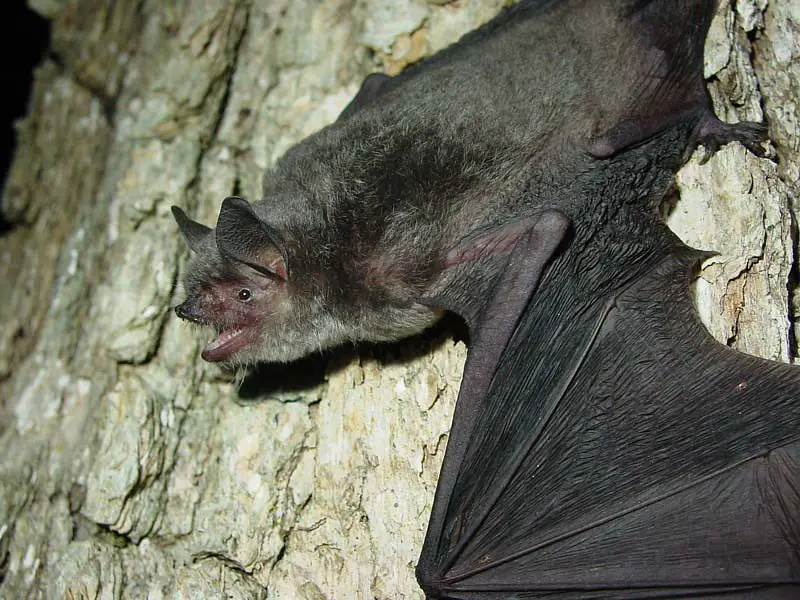Kentucky is famous for its rolling hills, horse farms, and vibrant seasons. Yet hidden beneath these landscapes lies one of the most extraordinary underground worlds in North America. Kentucky’s cave systems, especially those within the Mammoth Cave region, hold astonishing secrets about the bats that live inside them.
Most people think of bats only as dark silhouettes fluttering at dusk. In reality, bats inside Kentucky caves form complex societies, support entire ecosystems, and perform biological roles that scientists are still discovering. Their survival depends on delicate conditions found only in the underground chambers beneath the state’s forests and farmlands.
This article reveals shocking facts about Kentucky’s cave dwelling bats. Their behaviors, feeding habits, survival strategies, and ecological roles demonstrate how vital they are to the health of the region.
Understanding Kentucky Cave Bats

What Kentucky Cave Bats Really Are
More than a dozen bat species live in Kentucky. Many of these rely on caves as seasonal or year round homes. The most well known species include the Indiana bat, the gray bat, the little brown bat, the northern long eared bat, and the big brown bat.
Cave bats in Kentucky are insectivorous. Their diets consist entirely of insects such as moths, beetles, mosquitoes, and midges. These bats are essential for maintaining insect balance above ground.
Why Kentucky Is a Bat Stronghold
Kentucky contains thousands of caves with stable humidity, constant temperatures, and protected environments. Bats require environments that remain cool and safe during winter hibernation. The state’s geology provides these conditions better than almost anywhere else in the United States.
The Mammoth Cave system alone houses massive bat populations. Its miles of interconnected chambers offer ideal roosting areas.
Cave Microclimates That Support Bats
The temperature inside many caves remains between 40 and 55 degrees Fahrenheit throughout the year. Humidity remains high. Airflow is steady but gentle. These conditions prevent bats from losing water and energy during periods of inactivity.
Such stable underground climates allow bats to survive winter when insects are scarce.
Why Bats Choose Kentucky Caves
Ideal Hibernation Sites
During winter, bats rely on hibernation to conserve energy. Hibernation requires specific conditions. Kentucky caves provide cold yet stable temperatures that slow a bat’s metabolism to a fraction of its normal rate.
Without these caves many bat species would not survive the winter.
Safe Roosting Locations
Caves offer protection from predators such as hawks, owls, raccoons, and snakes. Deep cave chambers provide darkness and isolation that keep colonies secure.
Rock ledges, narrow crevices, and high cave ceilings give bats countless places to roost.
Long Term Habitat Stability
For thousands of years bats have depended on Kentucky caves. These underground ecosystems change slowly which allows bat colonies to remain stable when surface environments fluctuate.
Hidden Behaviors You Never Knew
Swarming Behavior Before Winter
As fall approaches bats gather in massive numbers outside cave entrances. This behavior known as swarming helps them socialize, mate, and prepare for hibernation.
Swarming can involve thousands of individuals circling twilight skies.
Precision Echolocation
Bats navigate total darkness using echolocation. They emit high frequency sounds and interpret echo patterns to map their surroundings. This allows them to detect insects as small as tiny moths in complete darkness.
Each species produces slightly different frequencies based on diet and environment.
Clustering for Warmth
During hibernation, some species cluster closely together to preserve heat. These clusters can contain hundreds of bats pressed against cave walls. This reduces individual energy loss and helps bats survive through winter.
Anatomy and Adaptations of Kentucky Cave Bats
Wings Designed for Maneuverability
Bat wings contain elongated finger bones covered by a thin membrane. This design allows incredibly precise turns and sudden dives. Such agility is essential for catching fast moving insects in the dark.
Lightweight Skeleton
Bat bones are thin and delicate which allows efficient flight. Their bodies are designed for maximum lift and minimal energy use.
Specialized Feet
Bats hang upside down using lockable tendons in their feet. They do not expend energy while hanging because the tendon structure grips automatically.
Feeding Habits of Bats in Kentucky
High Calorie Diets
Bats consume enormous quantities of insects each night. A single bat may eat thousands of insects during a few hours of activity. For a colony, this amounts to millions of insects nightly.
This feeding behavior reduces insect populations across Kentucky.
Seasonal Diet Shifts
During summer, bats focus on moths, beetles, mosquitoes, and aquatic insects emerging from ponds and rivers. In early fall they feed more heavily as they prepare for hibernation.
The availability of insects affects bat reproduction and survival.
Supporting Agriculture
Bats help control pests that threaten crops like corn, soybeans, and tobacco. They reduce populations of moths and beetles that cause significant agricultural damage.
Kentucky farmers indirectly benefit from healthy bat populations.
The Shocking Truth About Hibernation
Drastically Reduced Metabolism
During hibernation, bats slow their heart rate from hundreds of beats per minute to just a few beats. Their breathing becomes barely detectable. This metabolic reduction conserves energy.
Susceptibility to Disturbance
Disturbances during hibernation can be fatal. When bats are awakened, they burn enormous amounts of energy to warm their bodies. Repeated awakenings can cause starvation before spring.
This makes cave protection critical.
Fat Reserves Decide Survival
Bats build fat stores during fall. These reserves must last until spring. Even small interruptions in hibernation can reduce reserves enough to jeopardize survival.
Kentucky Caves as Bat Maternity Colonies
Summer Nursery Colonies
Female bats gather in specific warm caves to give birth. These maternity colonies contain hundreds or thousands of mothers raising pups together.
Warm temperatures accelerate pup growth.
Bat Pups’ Rapid Development
Pups are born blind and hairless but grow quickly. Within weeks they develop fur and learn to fly. Mothers feed pups with milk until they can hunt independently.
Collective Protection
Group size helps reduce predation. Many mothers leaving and returning together confuse predators and increase survival for pups.
Bats and Kentucky’s Insect Ecosystems
Controlling Mosquito Populations
Bats feed heavily on mosquitoes in Kentucky’s warm months. This reduces nuisance insect populations and supports outdoor recreation.
Regulating Moth and Beetle Numbers
Many agricultural pests fall into these categories. Bats reduce populations before they damage crops.
Supporting Food Chains
Bats are prey for owls, hawks, snakes, and even large fish when they feed near water. Their presence supports predators that depend on them.
White Nose Syndrome: A Hidden Crisis
What the Disease Is
White nose syndrome is a fungal infection affecting hibernating bats. It grows on bat skin especially around the nose and wings. It disrupts hibernation cycles and causes bats to wake frequently.
Impact on Kentucky Bats
Kentucky has seen major declines in little brown bats, Indiana bats, and other species. Some colonies have lost over 90 percent of their population.
How It Spreads
The fungus thrives in cool humid caves. It spreads through contact among hibernating bats. Disturbances inside caves amplify spread by causing bats to move.
Conservation Efforts
Kentucky biologists monitor caves, restrict public access, and study fungus resistance. Ongoing research offers hope for recovery.
The Role of Bats in Cave Ecosystems
Guano Enrichment
Bat droppings known as guano enrich cave floors with nutrients. Many cave insects, fungi, and microorganisms depend on guano as a primary food source.
Supporting Microbial Communities
Guano supports bacteria and fungi that decompose organic matter. These communities help maintain nutrient cycles in caves.
Influencing Cave Food Webs
Bats act as nutrient transporters. They bring energy from the outside world into caves through the insects they consume. This supports life deep in subterranean ecosystems.
Bats and Kentucky’s Night Skies
Evening Emergence
At dusk bats exit caves in swirling clouds. These emergence events attract birdwatchers, tourists, and researchers.
The movement is synchronized and precise.
Navigation Techniques
Bats use landmarks, magnetic fields, and light levels to navigate. They do not fly randomly. Their paths reflect knowledge of the surrounding landscape.
Interactions With Other Nocturnal Animals
Bats share nighttime environments with owls, nightjars, and predatory insects. Their aerial presence influences nighttime ecology.
Bats in Kentucky Forests and River Valleys
Roosting in Trees
Many species alternate between caves and trees. They roost in hollow trunks, bark crevices, or shaded foliage.
Following River Corridors
Rivers attract insects. Bats use these waterways as hunting routes. Kentucky’s Green River, Kentucky River, and Cumberland River are prime bat feeding grounds.
Using Abandoned Buildings
Old barns, sheds, and attics sometimes serve as summer roosts. These structures mimic natural caves.
Threats to Bats in Kentucky
Habitat Loss
Urbanization, timber harvesting, and agricultural expansion reduce roosting and foraging areas.
Pesticides
Insecticides reduce bat food sources. Chemicals accumulate in bat tissues causing long term harm.
Cave Disturbance
Unauthorized cave exploration disrupts hibernation and maternity colonies.
Climate Change
Temperature shifts affect insect populations which impacts bat feeding.
Conservation Success Stories
Protected Caves
Many Kentucky caves now restrict public access during critical seasons. This protects hibernating and maternity colonies.
Artificial Roost Structures
Bat boxes provide safe roosting sites in residential areas. This helps compensate for habitat loss.
Growing Public Awareness
Educational programs help people understand bats’ value. Communities now encourage bat conservation rather than removal.
How Residents Can Support Bats
Preserve Tree Cover
Trees provide summer roosts and hunting corridors.
Reduce Pesticide Use
Natural insect control supports bat health.
Install Bat Houses
Properly placed bat boxes attract colonies and reduce pest insects.
Respect Cave Closures
Following cave access guidelines protects vulnerable bat populations.
FAQs About Bats in Kentucky Caves
Are bats dangerous
They avoid humans and rarely interact with people.
Do bats carry rabies
A small percentage may carry rabies but risk is extremely low. Avoid handling bats.
Why do bats live in caves
Caves offer stable temperatures, protection, and hibernation conditions.
Are bats blind
No. They see well but rely on echolocation in darkness.
Do bats help reduce mosquitoes
Yes. They consume large numbers nightly.
How long do bats live
Some species live over twenty years.
Why do bats hang upside down
Hanging allows easy takeoff and energy conservation.
Can bats be relocated
Relocation is not effective. Bats often return to the same roost.
Are bats endangered in Kentucky
Several species face significant declines due to white nose syndrome.
Why do bats swarm at cave entrances
Swarming is part of mating and pre hibernation behavior.
Conclusion
Bats inside Kentucky caves represent one of the most complex and vital wildlife groups in the region. Their hidden behaviors, underground roosting habits, and incredible ecological roles reveal a creature that supports forests, farms, rivers, and communities across the state.
Understanding these shocking secrets helps shift public perception. Bats are not simply nocturnal visitors. They are key players in insect control, cave ecology, and environmental balance. Protecting them preserves the health of Kentucky’s ecosystems and supports the stability of natural processes that humans rely on every day.
As the underground world beneath Kentucky continues to evolve, bats will remain its quiet architects, influencing life above and below ground in ways many people never imagined.






